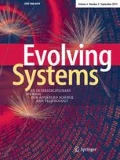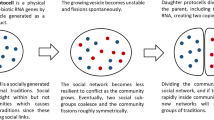Abstract
From the very beginning, human civilizations have evolved and spread across the surface of the planet Earth through various dynamical processes such as growth, assimilation, invasion, aggression, and annihilation. Such processes being responsible for expansion, integration, destruction, and reconstruction of civilizations, used to play key roles in the tides of time and fabric today’s multicultural societies. A culture, being an inherent entity of human civilization, also evolves in conformity with civilizations. As such, the evolution of cultures can be understood as an artifact of such dynamical processes. How such dynamical processes initiate the diversification of cultures from small-scale simple societies? Why most of the cultures go extinct and why some survive for a comparatively longer period even after facing several wars and attacks? What plays a key role in creating a multicultural society? In order to partially answer all such highly stimulating questions, here we are interested in tackling the problem by giving importance to the nature of governing dynamical processes. Hence we perform a set of computer simulations on an archetypal model where a large number of independent and isolated primitive human cultures, being distributed randomly in a two-dimensional domain, are allowed to evolve following some historically-inspired rules for expansion, interaction, and merging processes among the cultures. As they evolve through inter-cultural interactions, the surviving cultures dynamically inherit the characteristics of their ancestors, leading to a well-mixed globally-polarise culture that emerges depending on the frequency and casualties of wars, consequences of coalescence, and similarity factors. From the ensuing simulation results, we find in accord with the historical fact that the rich diversity in a surviving culture is a consequence of all the dynamical processes that act repeatedly during its entire evolutionary track. We also visualize through our model how a global monocultural state and colonization among multicultural societies emerge separately in the modern period. We highlight a number of possible avenues for future research along these lines.
















Similar content being viewed by others
References
Axelrod R (1984) The evolution of cooperation. Basic Books, New York
Axelrod R (1997) The dissemination of culture: a model with local convergence and global polarization. J Conflict Resolut 41:203
Bowden B (2009) The empire of civilization: the evolution of an imperial idea. The University of Chicago Press, London
Boyd R, Richardson PJ (2005) The origin and evolution of cultures. Oxford Univ. Press, Oxford, NewYork
Braudel F (1987) A history of civilizations. The Penguin Press, London
Carneiro RL (1970) A theory of the origin of the state. Science 169:733–38
Castellano C, Fortunato S, Loreto V (2009) Statistical physics of social dynamics. Rev Mod Phys 81:591
Cavalli-Sforza LL, Feldman MW (1981) Cultural transmission and evolution: a quantitative approach. Princeton University Press, Princeton
Conte R et al (2012) Manifesto of computational social science. Eur Phys J Spec Top 214:325–346
Dignum V, Dignum F (eds) (2014) Perspectives on culture and agent-based simulations. Springer, Switzerland
Distin K (2011) Cultural evolution. Cambridge University Press, Cambridge UK
Durant W (1935) The story of civilization: our oriental heritage. Simon & Schuster, New York
Elton CS (1958) The ecology of invasions by animals and plants. Springer, Methuen
Fáth G, Sarvary M (2005) A renormalization group theory of cultural evolution. Phys A 348:611–629
Gat A (2006) War in human civilization. Oxford University Press, New York
Grabowski A, Kosiński RA (2006) Evolution of a social network: the role of cultural diversity. Phys Rev E 73:016135
Henrich J, Boyd R, Richerson PJ (2008) Five misunderstandings about cultural evolution. Hum Nat 19:119–137
Huntington SP (1997) the clash of civilizations: remaking of the world order. Simon & Schuster, Touchstone
Keeley L (1996) War before Civilization: the myth of the peaceful savage. Oxford University Press, New York
Klemm K, Eguiluz VM, Toral R, San Miguel M (2005) Globalization, polarization and cultural drift. J Econ Dyn Control 29:321
Lodge DM (1993) Biological invasions: lessons for ecology. Trends Ecol Evol 8:133–137
Melko M (1969) The nature of civilizations. Porter Sargent, Boston
Mesoudi A (2011) Cultural evolution. Univ of Chicago Press, Chicago
Morgan LH (1877) Ancient society. Charles H. Kerr & Company, Chicago
Quigley C (1979) The evolution of civilizations. Liberty Press, Beverly
Richerson PJ, Christiansen MH (2013) Cultural evolution: society, technology, language, and religion. MIT Press, Oxford
Sarno S et al (2016) Ancient and recent admixture layers in Sicily and southern Italy trace multiple migration routes along the mediterranean. Sci Rep 7:1984
Sheppard R (2006) Empires collide. Osprey Publishing, Oxford
Stivala A et al (2014) Ultrametric distribution of culture vectors in an extended Axelrod model of cultural dissemination. Sci Rep 4:4870
Tainter JA (1988) The collapse of complex societies. Cambridge University Press, Cambridge
Talukdar D, Dutta K (2019) Impact of wars on the evolution of civilizations. Phys A 539:122881
Targowski A (2004) A grand model of civilization. Comput Civ Rev 51:81
Turchin P et al (2013) War, space, and the evolution of Old World complex societies. PNAS 110:16384
Turchin P, Gavrilets S (2009) Evolution of complex hierarchical societies. Soc Evol Hist 8:167–198
Whiten A, Ayala FJ, Feldman MW, Laland Kevin N (2017) The extension of biology through culture. PNAS 114:7775–7781
Wuketits FM, Antweiler C (eds) (2004) Handbook of evolution. Wiley-VCH, Oxford
Yoffee N (2004) Myths of the archaic states. Cambridge University Press, Cambridge
Acknowledgement
The work is funded by Science & Engineering Research Board (SERB), India through a project MTR/2019/000044.
Author information
Authors and Affiliations
Corresponding author
Additional information
Publisher's Note
Springer Nature remains neutral with regard to jurisdictional claims in published maps and institutional affiliations.
Electronic supplementary material
Below is the link to the electronic supplementary material.
Rights and permissions
About this article
Cite this article
Talukdar, D., Dutta, K. An archetype for evolving dynamics of primitive human culture. Evolving Systems 12, 965–979 (2021). https://doi.org/10.1007/s12530-020-09355-0
Received:
Accepted:
Published:
Issue Date:
DOI: https://doi.org/10.1007/s12530-020-09355-0




